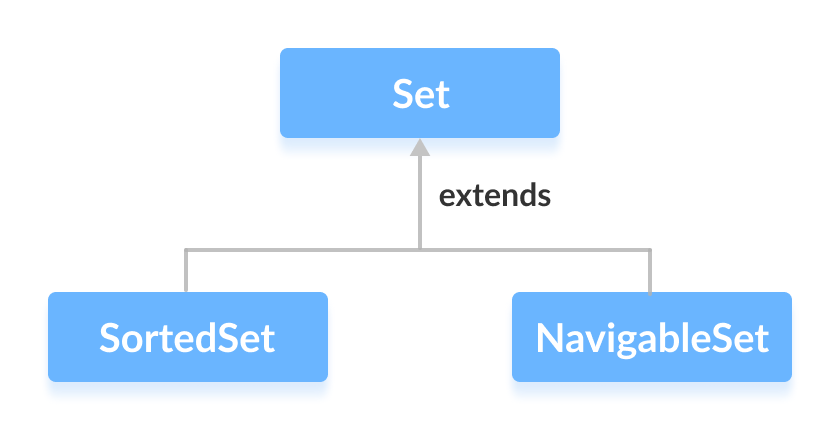The Set interface of the Java Collections framework provides the features of the mathematical set in Java. It extends the Collection interface.
Unlike the List interface, sets cannot contain duplicate elements.
Classes that implement Set
Since Set is an interface, we cannot create objects from it.
In order to use functionalities of the Set interface, we can use these classes:
These classes are defined in the Collections framework and implement the Set interface.

Interfaces that extend Set
The Set interface is also extended by these subinterfaces:

How to use Set?
In Java, we must import java.util.Set package in order to use Set.
// Set implementation using HashSet
Set<String> animals = new HashSet<>();
Here, we have created a Set called animals. We have used the HashSet class to implement the Set interface.
Methods of Set
The Set interface includes all the methods of the Collection interface. It's because Collection is a super interface of Set.
Some of the commonly used methods of the Collection interface that's also available in the Set interface are:
- add() - adds the specified element to the set
- addAll() - adds all the elements of the specified collection to the set
- iterator() - returns an iterator that can be used to access elements of the set sequentially
- remove() - removes the specified element from the set
- removeAll() - removes all the elements from the set that is present in another specified set
- retainAll() - retains all the elements in the set that are also present in another specified set
- clear() - removes all the elements from the set
- size() - returns the length (number of elements) of the set
- toArray() - returns an array containing all the elements of the set
- contains() - returns
trueif the set contains the specified element - containsAll() - returns
trueif the set contains all the elements of the specified collection - hashCode() - returns a hash code value (address of the element in the set)
To learn about more methods of the Set interface, visit Java Set (official Java documentation).
Set Operations
The Java Set interface allows us to perform basic mathematical set operations like union, intersection, and subset.
- Union - to get the union of two sets x and y, we can use
x.addAll(y) - Intersection - to get the intersection of two sets x and y, we can use
x.retainAll(y) - Subset - to check if x is a subset of y, we can use
y.containsAll(x)
Implementation of the Set Interface
1. Implementing HashSet Class
import java.util.Set;
import java.util.HashSet;
class Main {
public static void main(String[] args) {
// Creating a set using the HashSet class
Set<Integer> set1 = new HashSet<>();
// Add elements to the set1
set1.add(2);
set1.add(3);
System.out.println("Set1: " + set1);
// Creating another set using the HashSet class
Set<Integer> set2 = new HashSet<>();
// Add elements
set2.add(1);
set2.add(2);
System.out.println("Set2: " + set2);
// Union of two sets
set2.addAll(set1);
System.out.println("Union is: " + set2);
}
}
Output
Set1: [2, 3] Set2: [1, 2] Union is: [1, 2, 3]
2. Implementing TreeSet Class
import java.util.Set;
import java.util.TreeSet;
import java.util.Iterator;
class Main {
public static void main(String[] args) {
// Creating a set using the TreeSet class
Set<Integer> numbers = new TreeSet<>();
// Add elements to the set
numbers.add(2);
numbers.add(3);
numbers.add(1);
System.out.println("Set using TreeSet: " + numbers);
// Access Elements using iterator()
System.out.print("Accessing elements using iterator(): ");
Iterator<Integer> iterate = numbers.iterator();
while(iterate.hasNext()) {
System.out.print(iterate.next());
System.out.print(", ");
}
}
}
Output
Set using TreeSet: [1, 2, 3] Accessing elements using iterator(): 1, 2, 3,
Now that we know what Set is, we will see its implementations in classes like EnumSet, HashSet, LinkedHashSet and TreeSet in the next tutorials.